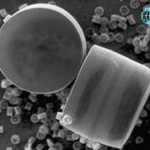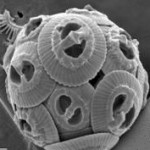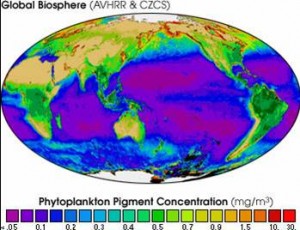
Recent research has suggested ocean nutrient levels are affected by human activities. But what does mean for tiny single-celled marine plants at the base of the food chain? Can they adapt when faced with decreased nutrient levels, or do they simply die? And what impact will this have on the rest of the food chain?
These are some of the big questions currently being asked by environmental scientists at Bournemouth University.
A new researcher in the department, Dr Daniel Franklin, has just published  a study on cell productivity under nutrient-restricted conditions, examining two important single-celled marine plants (a coccolithophore and a diatom).
a study on cell productivity under nutrient-restricted conditions, examining two important single-celled marine plants (a coccolithophore and a diatom).
The study is in response to growing concerns that the rise in ocean temperatures will restrict nutrient supplies to the marine plants at the base of the food chain.
Dr Daniel Franklin commented: “As the surface ocean warms, we know there will be an increase in stratification, whereby a warm skin of water lies over a colder, denser layer, which might restrict nutrient supply from the deeper water to shallow water and result in decreased productivity.”
The study just published in Limnology and Oceanography examined growth of the coccolithophore Emiliania huxleyi, often found in the subtropical open ocean, and the diatom Thalassiosira pseudonana which is often found in coastal seas.
“We showed that E. huxleyi cells adapt to declining nutrients in order to wait for more nutrients, and don’t die” said Dr. Franklin. “T. pseudonana, however, which is known to grow quickly in response to increased nutrients, did not adapt, and quickly died. These two types of response reflect the ecology of the two organisms in their natural habitat.”
But in addition to understanding how sensitive cells are to nutrient changes, these findings could inform how we measure ocean productivity in the future.
“Measuring the amount of photosynthetic pigments, mainly chlorophyll, is how we assess phytoplankton productivity on the macro-scale. We measure pigments from satellites. As part of this work we have been looking at how pigments alter during cell decline so that we can refine our understanding of how productivity can be measured at the macro-scale,” said Dr. Franklin.
The full paper, entitled ‘Identification of senescence and death in Emiliania huxleyi and Thalassiosira pseudonana: Cell staining, chlorophyll alterations, and dimethylsulfoniopropionate (DMSP) metabolism’ can be viewed through the Limnology and Oceanography website.












 3C Event: Research Culture, Community & Cookies – Tuesday 13 January 10-11am
3C Event: Research Culture, Community & Cookies – Tuesday 13 January 10-11am Dr. Chloe Casey on Sky News
Dr. Chloe Casey on Sky News Final Bournemouth University publication of 2025
Final Bournemouth University publication of 2025 On Christmas Day in the Morning…
On Christmas Day in the Morning… New Nepal scoping review on maternal & neonatal health
New Nepal scoping review on maternal & neonatal health ECR Funding Open Call: Research Culture & Community Grant – Application Deadline Friday 12 December
ECR Funding Open Call: Research Culture & Community Grant – Application Deadline Friday 12 December MSCA Postdoctoral Fellowships 2025 Call
MSCA Postdoctoral Fellowships 2025 Call ERC Advanced Grant 2025 Webinar
ERC Advanced Grant 2025 Webinar Horizon Europe Work Programme 2025 Published
Horizon Europe Work Programme 2025 Published Update on UKRO services
Update on UKRO services European research project exploring use of ‘virtual twins’ to better manage metabolic associated fatty liver disease
European research project exploring use of ‘virtual twins’ to better manage metabolic associated fatty liver disease